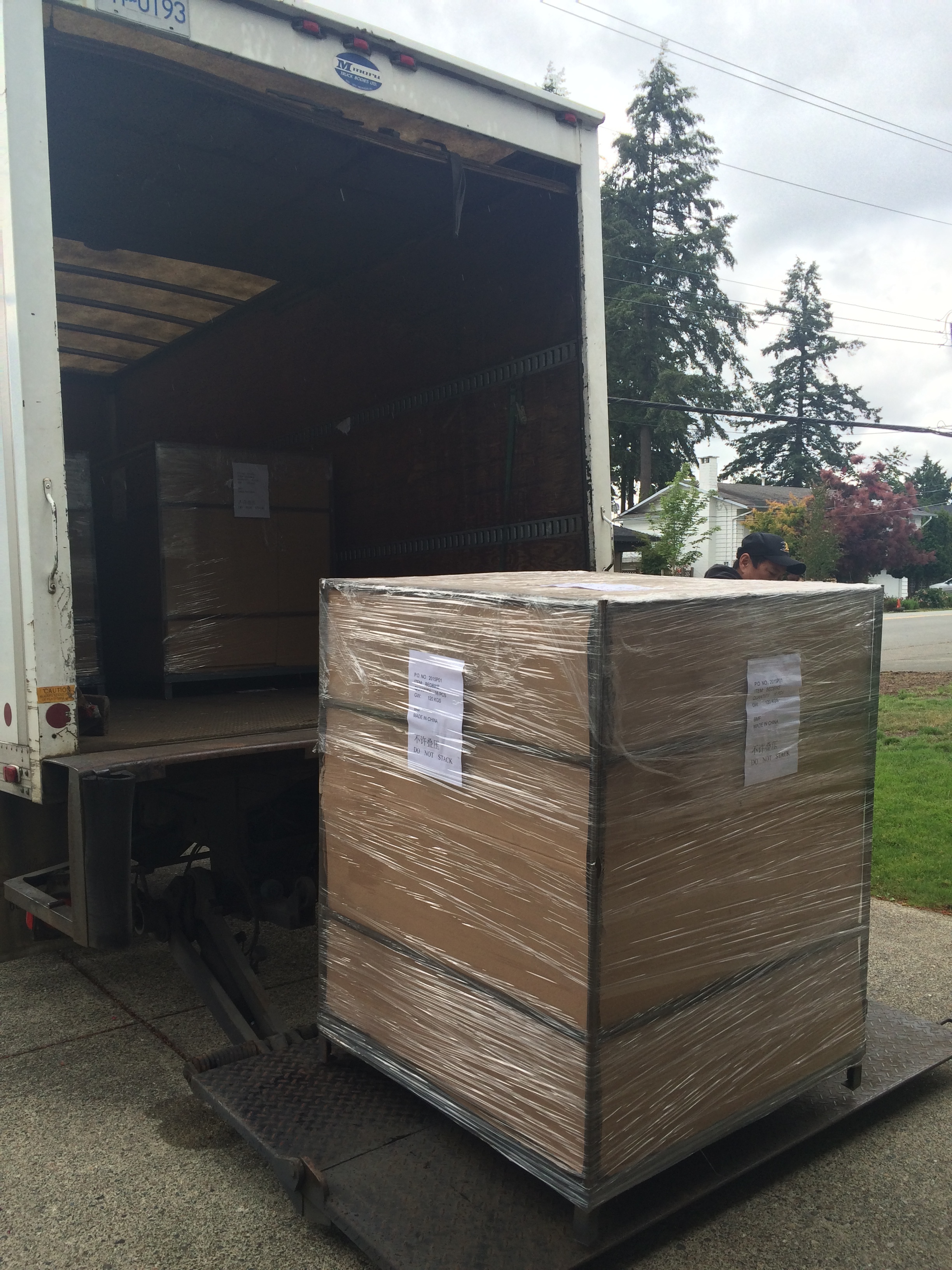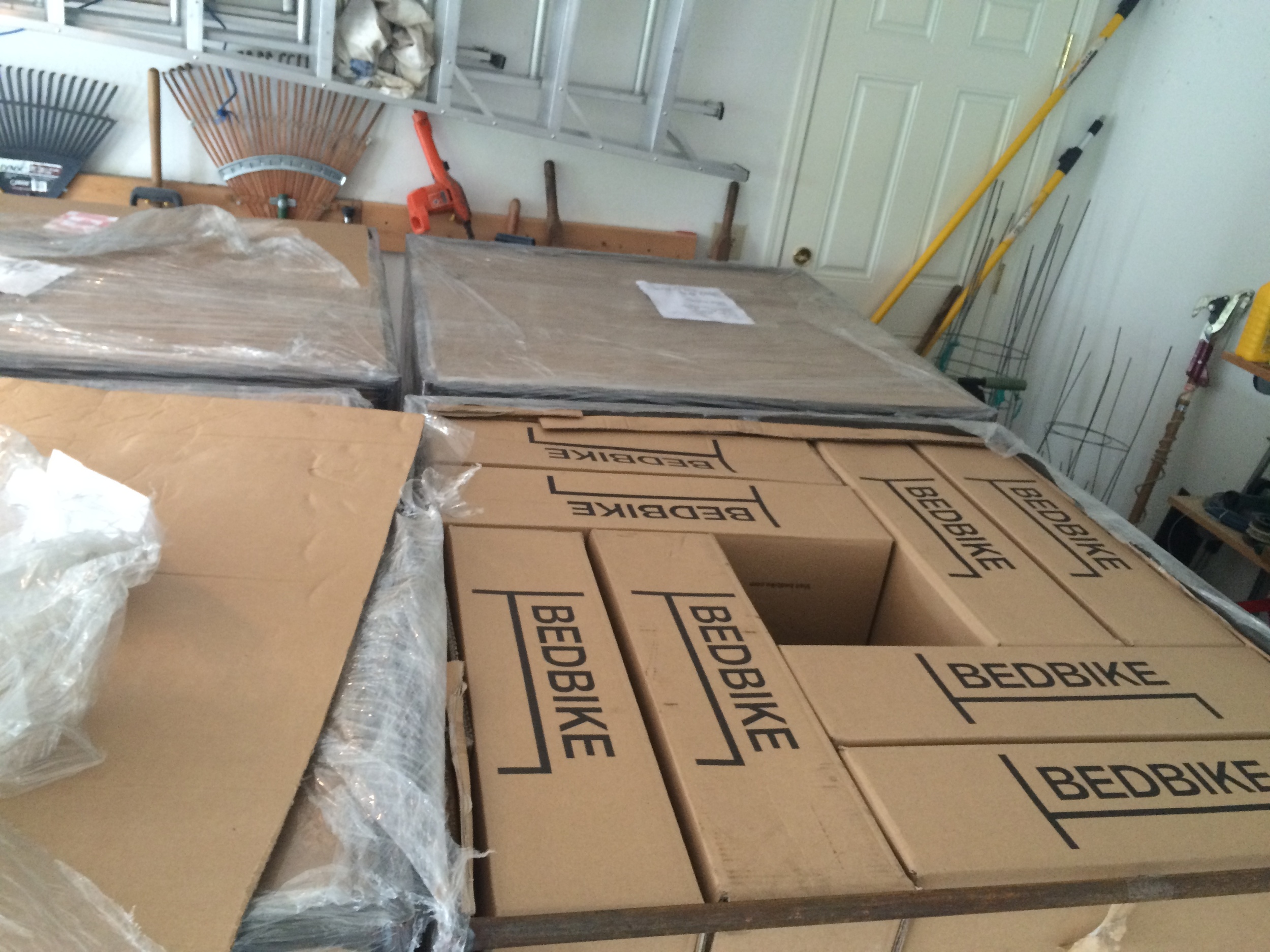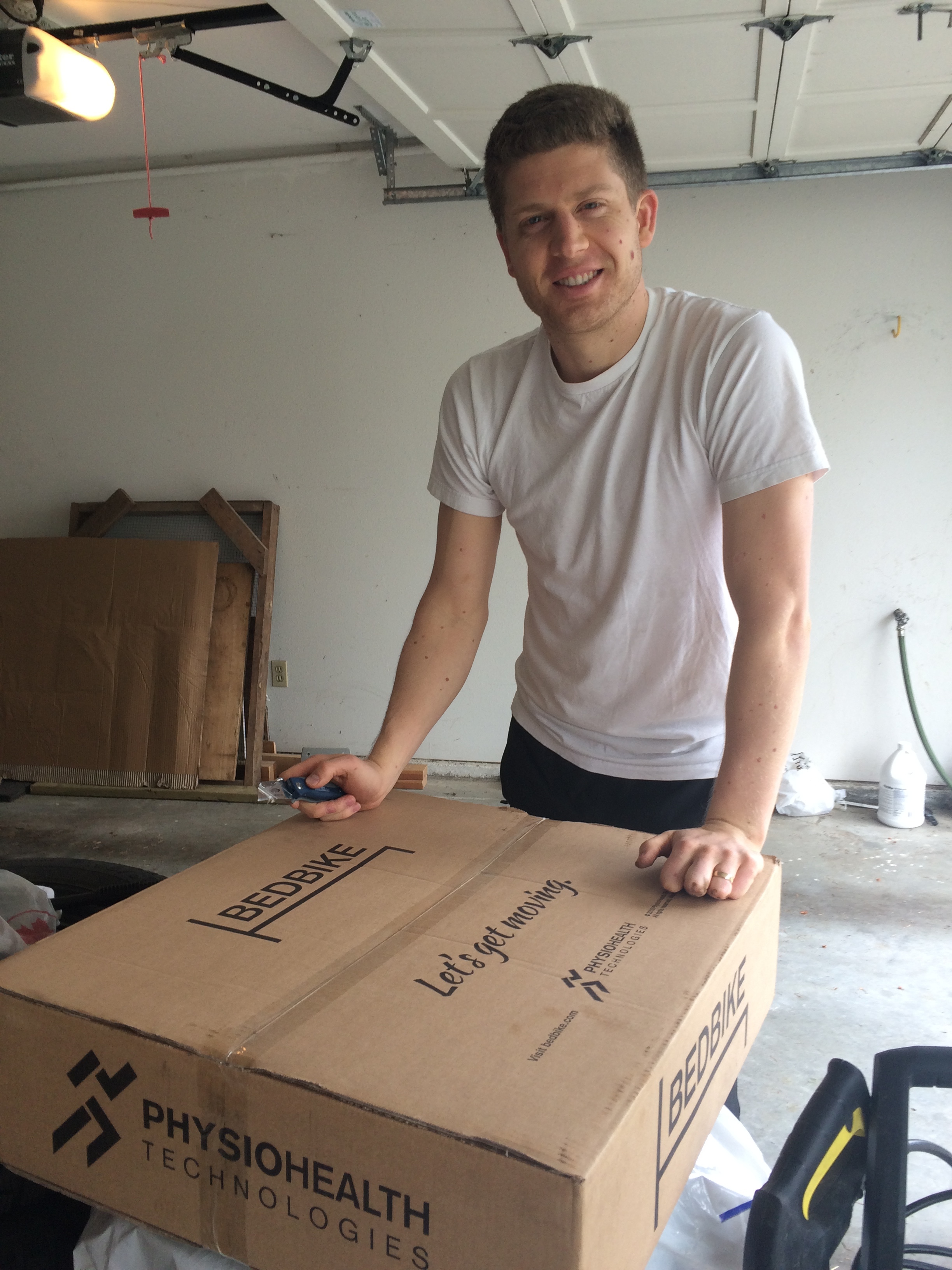The Story of BedBike
We're often asked, "How did BedBike start?" It's a good story, so we sat down our CEO Kyle Freedman to find out.
FALL 2013
"If Mom becomes independent again, we can bring her home. Can you help regain her strength?" Mary's daughter pleaded.
Physiotherapist Kyle Freedman, who later founded PhysioHealth Technologies, was assessing Mary for the first time in her mechanical bed at CareLife Fleetwood.
A diabetic, Mary had recently undergone double mid-thigh amputations. She had a long journey of recovery ahead of her. Unless Mary regained the strength to self-transfer and self-mobilize in a wheelchair, she would have to live in a full-care facility. Her age, condition, and current function would make that difficult, and Kyle gently attempted to tell the family. "She needs a lot of exercise. Ideally twice a day, and someone to guide her through an exercise program." The most he could accommodate in his community therapist schedule, while also balancing shifts at a multi-disciplinary clinic, was three times a week.
"Give her something she can do while you're not here," Mary's daughter insisted. "Something she can do in bed."
There isn't anything like that, Kyle remembered thinking. Sure, there were some arm ergometer models available through medical distributors—ones that were affixed to bulky tables and could be wheeled up to a mechanical bed. But they were expensive, and Mary's facility didn't have one.
And then it struck him. Maybe he could invent something new.
That was the start of BedBike. Kyle purchased a basic front mounted arm ergometer online and, with some basic workshop skills, attached a wooden base that would fit over Mary's lap.
Mary loved it. Her family was ecstatic. "We'll remind her to exercise every day."
What was more, the nurses at CareLife Fleetwood loved it. "They thought it was a great idea," Kyle remembers. One nurse told him:
"I love it! It is so portable and easy to use. Just think how many people benefit from this! You should tweak this design and start a company."
That really got Kyle thinking. The health benefits of arm ergometry in hospitals had been well-documented in numerous research studies. Arm ergometry prevented pneumonia, because it enabled lung expansion in people spending much of the day sitting or in bed. If such a device could help prevent pneumonia, hospital discharge times would be much shorter too! It would increase strength and ability to self-transfer in and out of bed or wheelchairs, and the exercise would benefit heart health, blood sugar levels, blood pressure—even dementia prevention. Why hadn't anyone invented a portable arm ergometer before?
Observing the community facilities with a fresh perspective, Kyle noticed that there was a great emphasis in getting patients out of bed and into a wheelchair—which naturally resulted in the opportunity for mobility. But many patients lacked the strength to wheel themselves around. And, once in a wheelchair, there were few options available to enable a beneficial bout of exercise; one that would raise heart rates to optimal levels.
"Often there is a recreation room, perhaps with a stationary bicycle, or an arm ergometer bolted to the wall," Kyle says. "But the challenge remains, in getting the patient there. We felt like we could improve on that efficiency—by flipping the paradigm. We started to design BedBike: a portable arm ergometer you could bring to patients in bed."
A retirement facility rarely employs physiotherapists, but at the very most there is one to oversee the entire facility. Many residents in complex care do not stand up and walk without the help of a physiotherapist. Care aides and nurses are not trained to walk individuals that are a high falls risk, and quite simply, they don't have time to walk anyone even if they were trained.
BedBike would enable any staff member to bring the exercise to the resident, leave them safe and unsupervised and exercising in bed.
SPRING 2014
The first prototype was heavy—it was steel tubing, and weighed about 25 pounds. It was a good start, to get the feel for the mechanics of how such a product might work. "We knew we wanted a foldable model from the very beginning. Space is always limited, and so a collapsible unit was extra practical." To bend the steel tubing, Kyle enlisted the help of a friend who taught high school shop, and had access to the tools he needed.
SUMMER 2014
The next challenge was figuring out how to build the next model with aluminum. Kyle purchased a basic aluminum walker online, complete with the standard spring button legs often seen on crutches. "I didn't know anything about metal work or brake mechanisms," Kyle admits. "I had a few engineering friends and a jack-of-all-trades father-in-law, but the only expertise I was bringing to the table was my physiotherapy background." He made the first sketches on scraps of paper at home, using the same easy-to-adjust design as a walker, and the collapsibility of the front-mounted walker Mary used. The pedals also needed to be ergonomic, like hand cycle handles. "Why were arm ergometer handles still horizontal?" Kyle wondered. That orientation caused shoulder impingement and irritation to the web space between thumb and forefinger.
FALL 2014
Once his engineering friends had done 3D SolidWorks drawings of BedBike, Kyle was ready to build a professional prototype. Only several companies in the Lower Mainland could bend aluminum tubing, so he had trouble getting quotes. "If I wanted to show this to hospitals and facilities, it had to look good. Not something I Frankensteined out of other pieces." He contacted TDS Technologies, a local manufacturing company who produced custom steel machining.
TDS built the first complete BedBike prototype, including medical grade anodizing and an etched logo. "I'm not creative," says Kyle. "Fortunately, I married my opposite. My wife does all the web and print design, communications, and admin—which I'm very grateful for."
There was only one problem: the end price. "I couldn't afford it, and neither could the end user. Not even close." Though the idea of using a Canadian manufacturer appealed to him, Kyle had to concede to the simple math reality. "For the price of one built in Canada, we could build three overseas." So, overseas he searched.
All the while, Kyle brought the BedBike prototype to his patients in various community facilities.
Across the board—the directors of care, general managers, directors of recreation—all answered, "We love it. Let us know when it's ready." The only concern he received was for the lack of outcome measures. Taking it to heart, Kyle made notes to include a numbered sticker on the resistance knob and a removable timer for the next prototype.
SPRING 2015
The first overseas manufacturer was a disaster. "I sent them the mechanical drawings and spent over 100 hours on Skype, often at midnight our time, answering their questions over and over again. Language was a big barrier, but even looping in a translator didn't seem to help much. Technical mechanical instructions are difficult to translate." After six months of delays, the manufacturer sent..."Well, I wouldn't call it a BedBike," Kyle says. "The handles were welded on. You couldn't pedal. The legs didn't click into place: they didn't even attach. It was pretty devastating."
Discouragement set in. Many aspiring entrepreneurs halt product design for the same reasons Kyle had found: high start-up costs, considerable risk, time commitment, and an ever-increasing amount of stress. Just when he was beginning to wonder if he should throw in the towel, the sky cleared. It's a small world: Kyle's uncle and aunt heard of his manufacturing difficulties and happened to know a reputable company in Shanghai. The owner of Brantingham Manufacturing (BMF) and Kyle's relatives had gone to the same church for many years.
SUMMER 2015
Kyle hired BMF to subcontract the manufacturing and provide quality control, visiting factories on his behalf and coordinating the sourcing of materials and overall production. "I couldn't have asked for a better set up. They knew the local businesses, the culture, the language, and they were also familiar with North American industry standards."
There was just one problem: most North American companies manufacture overseas to reduce costs on large quantity orders—that is, 10,000+ units. As an initial investment and market test, PhysioHealth Technologies only wanted 100 BedBikes. BMF's subcontractors kept giving the same answer: "Sorry, we can't do an order that small." One manufacturing company reluctantly agreed, provided that we double our order. "200 BedBikes cost about twice as much as 100—at those numbers, volume discounts don't really kick in yet," says Kyle. With few other options, PhysioHealth Technologies agreed, and a verbal agreement was exchanged through BMF. "Of course," Kyle laughs, "the very next day the manufacturer countered and said the order would have to be 300 BedBikes. We just nodded and kept moving forward."
Production for Prototype No. 5 began. Kyle sent Prototype No. 3 for his manufacturer to copy and source identical materials.
Every step of the way, there was something new to learn, some new challenge. "There aren't many who are set up to anodize with the thickness required for medical grade standards accepted in North America," Kyle explains. "If the anodizing is too thin, then there is a chance the harsh cleaning chemicals in hospitals will ruin the product surface." BedBike's original mechanical drawings were done in imperial, as was the Canadian standard. "When the manufacturer converted to metric, some of the Chinese-equivalent sizings meant that pieces weren't fitting as they should." Every curve, width and length was re-analyzed.
FALL 2015
Prototype No. 5 was good, and Prototype No. 6 was near-perfect. "We designed a new, easy-to-maintain brake mechanism that wouldn't wear down. This produced more heat. So we tooled black sheaths for the crank arms, to protect against over-heating. Most ergometers are bulky and heavy with a large central compartment," Kyle explains, "to address the heat generated from pedalling. We wanted to build a product that was light, ergonomic, and easy to use. After 6 prototypes, we finally did it!"
2016
After meeting all spring with 10+ hospitals and care facilities in the Lower Mainland and securing their interest in trialling, Kyle ordered his first shipment of BedBikes. On June 23, 2016, the YANG MING CYPRESS chugged into the Delta, BC port yard.
"Everyone has to get paid," Kyle laughs. "Production costs covered the BedBike units, plastic moulds, and welding jigs, but here's a fun fact for aspiring entrepreneurs out there: there are always fees you won't anticipate. You've got to pay someone for craning the container off the ship, pay for customs inspections, pay for truck delivery...and don't forget to pay the guy who's coordinating all this port activity. Then you have general liability insurance for a medical product, Health Canada licensing and inspections, and WorkSafeBC coverage, which all have to be activated before you can start selling."
80 BedBikes were delivered to Kyle's parents' empty basement. Thank goodness for free storage. What Kyle imagined would be five pallets, were in fact five steel cages, encapsulating the individual cardboard boxes. "We had to lift out one box at a time, from the top." Kyle laughs. "And then I had to borrow a hacksaw to dismantle the empty cage."
Even the final lap has hills. "The glue attaching the removable timers to the main tower failed. I had to open every single box, clean every single magnet and washer, and re-apply two-part epoxy." The basement storage space quickly converted into a makeshift magnet re-attachment shop. "As far as manufacturing imperfections go, this was the best thing to have gone wrong," Kyle says. It was not quick, but it was an easy fix. The function of the BedBikes remained uncompromised.
Currently, more than a dozen Lower Mainland hospitals and facilities are trialling BedBike. We're proud to announce that seven (as of October 2016) have already purchased units, and we expect more will follow. It's been a long road. Two and a half years of development. Six prototypes. Well over 1,000 hours of work. Kyle's still smiling. "I'm really excited about the impact BedBike could have on senior health care. It's too important not to do everything we can."
Ripple effects into the various health authorities will take time. There are lots of meetings yet to be had, and many to bring on board. Still, Kyle is encouraged. "The resounding interest we've received from both patients and health care professionals has been so consistent, we know we've identified a need. Families want Mom and Dad to live at home as long as possible. They want to help them stay mobile and healthy, for as long as possible. We want to help them do that."















